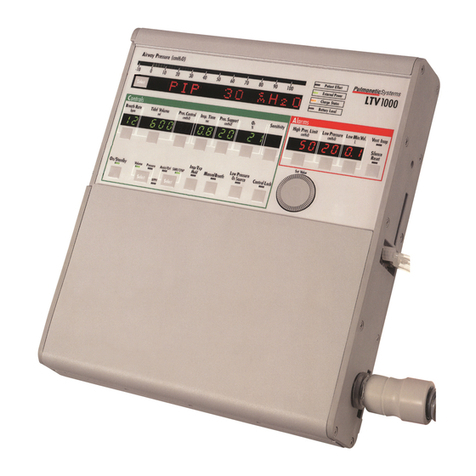
Page viii LTV®Series ventilator Operator’s Manual
p/n 10664, Rev. Y
Alarm Volume ............................................................................................................................ 10-3
Apnea Interval............................................................................................................................ 10-4
High Pressure Alarm Delay ....................................................................................................... 10-4
Low Peak Pressure Alarm ......................................................................................................... 10-4
High f.......................................................................................................................................... 10-5
High PEEP................................................................................................................................. 10-5
Patient Assist ............................................................................................................................. 10-6
Exit ............................................................................................................................................. 10-6
Vent Operations ............................................................................................................................ 10-7
Variable Rise Time..................................................................................................................... 10-8
Variable Flow Termination ......................................................................................................... 10-9
Variable Time Termination....................................................................................................... 10-10
Pressure Control Flow Termination ......................................................................................... 10-11
Leak Compensation................................................................................................................. 10-12
NPPV Mode ............................................................................................................................. 10-13
O2 Flush (LTV® 1000 Only) .................................................................................................... 10-14
Control Unlock ......................................................................................................................... 10-15
Language Selection ................................................................................................................. 10-15
Software Version...................................................................................................................... 10-16
Usage Meter ............................................................................................................................ 10-16
Communications Setting.......................................................................................................... 10-16
Set Date ................................................................................................................................... 10-17
Set Time................................................................................................................................... 10-18
Date Format............................................................................................................................. 10-18
PIP LED ................................................................................................................................... 10-19
Model Number / Serial Number ............................................................................................... 10-19
Valve Home Position ............................................................................................................... 10-20
Set Defaults ............................................................................................................................. 10-20
O2 Cylinder Duration (LTV® 1000 Only) ................................................................................. 10-21
Exit ........................................................................................................................................... 10-22
Transducer Autozero................................................................................................................... 10-23
Airway Pressure Transducer Autozero.................................................................................... 10-23
Bi-directional Flow Transducer Differential Autozero .............................................................. 10-24
Exhalation Flow Transducer Differential Autozero - Narrow ................................................... 10-25
Exhalation Flow Transducer Differential Autozero - Wide....................................................... 10-26
Real Time Transducers............................................................................................................... 10-27
Chapter 11 - Ventilator Checkout Tests........................................ 11-1
Alarm Test..................................................................................................................................... 11-3
Display Test................................................................................................................................... 11-4
Control Test................................................................................................................................... 11-6
Leak Test....................................................................................................................................... 11-8
Vent Inop Alarm Test .................................................................................................................. 11-10
Exit .............................................................................................................................................. 11-12





























